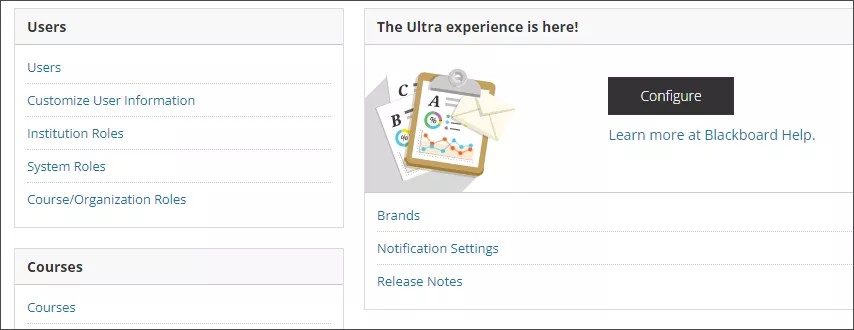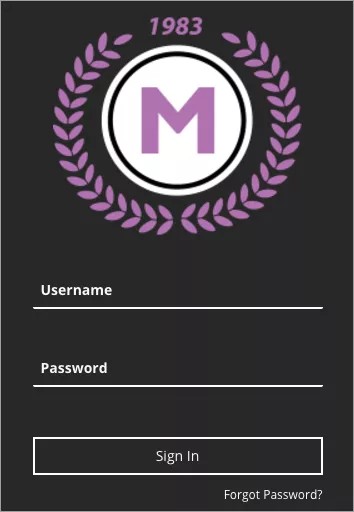Base Navigation must be enabled by July 31, 2024. Need help?
- Connect with a Navigation Liaison: Schedule a meeting
- Explore upgrade resources: Base Navigation Upgrade Toolkit
- Read the announcement: Important Update on Legacy Navigation for Blackboard Learn
Ready to roll?
To enable the Ultra experience on your production environment, submit a ticket to Blackboard Support on behind.blackboard.com to receive access. A Blackboard representative will contact you to discuss the impact of enabling Ultra on your institution's environment, students, and faculty.
When you enable the Ultra experience in your Test environment, you won't be able to switch back to the Original experience without completely rebuilding the environment and losing all data.
After you've consulted with a Blackboard representative, you have the ability to enable the Ultra experience. From the Administrator Panel, select Configure under The Ultra Experience is here!
Enable
Switch to the Ultra experience. After you turn on the Ultra experience, you can't turn it off.
Configure
After you enable the Ultra experience, you can change the default course settings to use the Ultra Course View for all new courses. Or, you can allow instructors to choose a course view for each of their courses. To choose the default course view option, go to Courses Settings and then select Default Course Properties.
More about the two course views
Do Not Enable
Make no change to your current Blackboard Learn experience.
Add or change your logo
In the Ultra experience, administrators can add an institution logo to the Learn Ultra login page as well as the base navigation.
More on institution branding in the Ultra experience
Change the landing page
By default, users start on the Activity Stream after they log in to Blackboard Learn with the Ultra Experience. You may want to display another area more prominently for users, especially if you've taken time to build the Institution Page with important and time-sensitive content. You can change the Ultra landing page to highlight more relevant information for your institution's users.
- From the Administrator Panel, in The Ultra Experience is Here! section, select Configure.
- Under Default Landing Page, choose which page users will visit first when they log in to Ultra: Activity Stream, Course List, or Institution page. Select Save.
Link to course catalog
Users can use the course catalog to browse the available or upcoming courses at your institution.
To enable users to open and browse the course catalog in the Ultra experience, toggle on Link to Course Catalog. Available courses in the Original course view and the Ultra course view appear in the course catalog. Users can open the courses and view contents, but they can't interact with the content.
If the guest option is enabled for a course in Original course view, guests can access those courses in the catalog.
Link to organization catalog
If your institution has access to the community engagement features, the organization catalog lists all organizations in categories, such as organization type or semester availability.
To enable users to open and browse the course catalog in the Ultra experience, toggle on Link to Organization Catalog.
Activate an additional level of nested items
If most of your courses/organizations have deeply nested content, you may want to enable additional nesting levels. The additional folder depth will reduce the "flattening" of course/organization content during the conversion process for these types of courses.
To enable additional levels, toggle on Activate an Additional Level of Nested Items and then complete the confirmation screen. For more information, see Activate an additional level of nested items.
Convert content areas to learning modules
Content areas in Original courses and organizations become learning modules when converting to Ultra. If you leave Convert content areas to learning modules toggled off, content areas become folders.
Learning modules provide improved student and participant navigation, allowing them to quickly move to the next or previous item while keeping track of their progress by seeing the number of completed items. Instructors and Leaders can personalize learning modules with thumbnail images and have the option to force students and participants to work through materials sequentially. For more information, see Create learning modules.
User engagement surveys and product updates
In-product updates help users understand changes and effectively use new features. Product updates are brief mentions of what is new in Blackboard Learn. User engagement surveys are brief polls launched to a small sample of users. Each survey has its own purpose. For example, a survey might ask users to rate their overall experience of a feature or workflow. For more information, see In-product updates and user engagement surveys.
To enable these features for your institution's Learn users, toggle on User Engagement Surveys and Product Updates.


